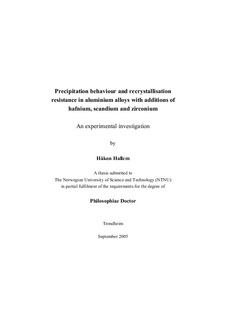| dc.contributor.author | Hallem, Håkon | nb_NO |
| dc.date.accessioned | 2014-12-19T13:25:05Z | |
| dc.date.available | 2014-12-19T13:25:05Z | |
| dc.date.created | 2006-02-27 | nb_NO |
| dc.date.issued | 2005 | nb_NO |
| dc.identifier | 124909 | nb_NO |
| dc.identifier.isbn | 82-471-7176-7 | nb_NO |
| dc.identifier.uri | http://hdl.handle.net/11250/248731 | |
| dc.description.abstract | The overall objective of this work has been to develop aluminium alloys, which after hot and cold deformation are able to withstand high temperatures without recrystallising. This has been done by investigating aluminium alloys with various additions of hafnium, scandium and zirconium, with a main focus on Hf and to which extent it may partly substitute or replace Zr and/or Sc as a dispersoid forming elements in these alloys.
What is the effect of hafnium, alone and in combination with Zr and/or Sc and how do hafnium containing alloys perform?
It is shown that hafnium may alter or modify the casting structure, though, not to the better as it can form TCGs in combinations with Zr and/or Sc. This is not advantageous neither as far as it concerns grain refining nor precipitation of dispersoids.
When precipitation of binary Al-Hf is compared to Al-(Hf)-(Zr) alloys, hafnium shows even slower precipitation than in Al-(Hf)-(Zr) alloys and also much slower and with a poorer spatial distribution of dispersoids than in Al-Sc or Al-Hf-Sc alloys. As a consequence, it may be concluded that binary aluminium-hafnium alloys are of limited interest as they display a poor recrystallisation resistance when no other alloying elements are added.
However, when hafnium is added together with scandium and/or zirconium, precipitation may actually improve both in Al-Hf-Zr alloys and in scandium containing alloys like Al-Hf-Sc and Al-Hf-Sc-Zr. Hafnium can still not completely replace neither Zr nor Sc due to its poor precipitation properties. However, Al-Hf-Sc-Zr alloys show a better dispersoid distribution (number density and volume fraction) than what was observed in Al-Sc-Zr alloys after extrusion. The Al-Hf-Sc-Zr alloys also show extreme high temperature properties, by withstanding recrystallisation at high temperatures and long annealing times. After severe cold deformation, the extruded profiles of both the Al-Sc-Zr alloy and the Al-Hf-Sc-Zr alloy displayed a remarkable recrystallisation resistance.
The reason why the Al-Zr-Sc- and the Al-Hf-Zr-Sc alloys behave so well has been investigated by detailed 3D Atom Probe investigations. Due to the homogeneous precipitation of Al3Sc dispersoids and the retarding effect from Hf and/or Zr containing shells, thus limiting the coarsening of these dispersoids, these combinations have been shown successful.
As we have seen when Hf and Zr are added in combination equal or improved recrystallisation properties can be obtained. This is specially the case when both these elements are added together with scandium. Since Hf and Zr are extremely difficult (and thus costly) to separate, Al-Zr master alloys used in industry today can in the future probably contain more Hf, lowering the cost of master alloys.
The work presented in this thesis have hopefully added some new insight and a better understanding of the effects of adding various dispersoid forming elements to aluminium, alone and in various combinations, which may be useful for industry today and a basis for further alloy development. | nb_NO |
| dc.language | eng | nb_NO |
| dc.publisher | Fakultet for naturvitenskap og teknologi | nb_NO |
| dc.relation.ispartofseries | Doktoravhandlinger ved NTNU, 1503-8181; 2005:145 | nb_NO |
| dc.subject | TECHNOLOGY: Materials science | en_GB |
| dc.subject | Materialteknologi | no_NO |
| dc.subject | aluminiumlegeringer | no_NO |
| dc.title | Precipitation behaviour and recrystallisation resistance in aluminum alloys with additions of hafnium, scandium and zirconium | nb_NO |
| dc.type | Doctoral thesis | nb_NO |
| dc.source.pagenumber | 191 | nb_NO |
| dc.contributor.department | Norges teknisk-naturvitenskapelige universitet, Fakultet for naturvitenskap og teknologi, Institutt for materialteknologi | nb_NO |
| dc.description.degree | PhD i materialteknologi | nb_NO |
| dc.description.degree | PhD in Materials Technology | en_GB |
